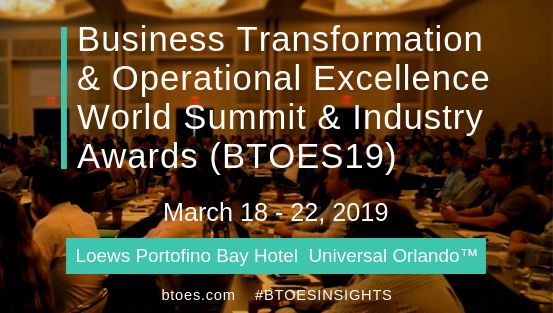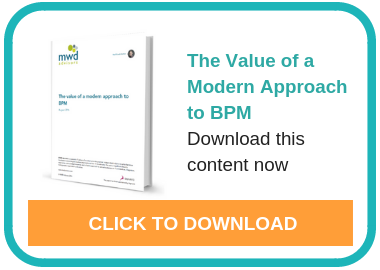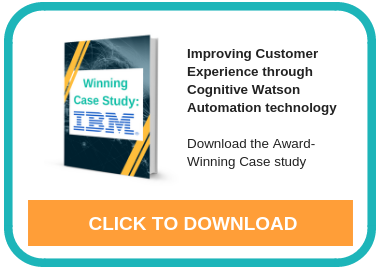What is Business Process Management (BPM)?
A Definition of Business Process Management
Browsing through the internet, looking for a definition of BPM might not be helpful, as there are many inaccurate definitions.This definition by Gartner summarizes BPM to the point:
"Business process management (BPM) is a discipline that uses various methods to discover, model, analyze, measure, improve, and optimize business processes. A business process coordinates the behavior of people, systems, information, and things to produce business outcomes in support of a business strategy (Processes can be structured and repeatable or unstructured and variable). Though not required, technologies are often used with BPM. BPM is key to align IT/OT investments to business strategy"
A business process can refer to any activity, or set of activities, that accomplishes a particular organizational goal. Often typified now by the numerous Business Process Management software solutions available on the market, Business Process Management (or BPM) is a step away from Operational Excellence and Lean's typical domain of Manufacturing, focusing more closely on streamlining and improving administrative processes, reducing human error, and infrastructure management.
Business Process Modeling
Business Process Modeling
Business Process Modeling is part of Business Process Management and is the activity of identifying, defining and visualizing processes of a company, in order to analyze and improve them. Additionally the process can be automated with BPM software and other tools.
There are different Business Process Modeling techniques, here are some of the most commonly used:
- Business process Modeling Notation (BPMN)...is a flowchart technique that helps modeling whole business processes and includes all information needed. I usually standartized symbols are used so that everybody knows what is meant. It also depicts parallel activities which are part of the process. For beginners and less complex processes it might be easier to use the original Flowchart technique, which was the forerunner if BPMN.
- UML Diagrams... use Unified Modeling Language (UML) to model processes.
- Gantt Charts...focuses on the time aspect of processes. Although some companies still use it because it used to be one of the best modeling techniques, many people nowadays think it is too simple and it is better to use more evolved techniques.
- PERT Diagrams.. combine Gantt charts and BPMN, as you can not only represent tasks and workflows it also helps schedule the tasks, and compare different approaches to a process.
- Petri nets and Colored Nets (CPN)s...although this technique is quite hard to learn, as the language used is very complicated, once you learned it you can do great things! You can depict processes which happen simultaneously. You can also also represent parallel sub-processes inside main processes.
As mentioned BPM techniques can be used on their own, but it is better to align them with a BPM software, to achieve best results.
Don't confuse Business Process Modeling with Business process Mapping. According to medium.com:
A Business Process Map is..."a one-dimensional picture or drawing of a linear sequence flow of activities in a business process, disconnected from other factors of the business."
A Business Process Model is..."is a rich, detailed representation of how a process works within the context of the overall business environment, and includes operating information like time and cost."
Watch this video 'Linking your Business' Core Processes and Process Architecture with Strategy', by Sandy Furterer, Associate Professor at University of Dayton and former VP, process Transformation, Park National Bank
A Critical View on BPM
Does BPM have to change?

found on www.crazyegg.com
"As a discipline, Business Process Management (BPM) is now undeniably a well-established aspect of any modern, succesfull company's operational strategy for the digital age. Yet although the benefits and aims of Process Management are clear, getting there can sometimes prove challenging. So what do we need to improve in classic BPM initiatives to reflect the digital age and to harness as much value as we can from our processes?
There are three core elements that shoud be embraced by modern, fit-for-purposed BPM initiatives:
- BPM needs to be collaborative and inclusive
- BPM practice needs to go beyond modeling and also embrace the operationalization of business processes in modern digital workplaces
- BPM needs to be agile and iterative"
Click here to read more about '3 Ways BPM must change to reflect the digital world' by Niamh McShane, Signavio. (This content was originally posted on Signavio.com and has been repurposed for Btoes.)
BPM Software
BPM Software
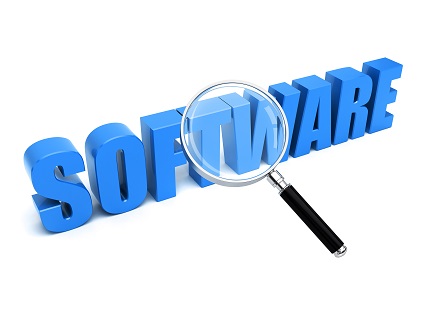
found on primeoffspace.co.uk
Business Process Management Softwares support companies in Business Process Management in order to make the processes more efficient. Quick reminder:
"Business process management (BPM) is a discipline that uses various methods to discover, model, analyze, measure, improve, and optimize business processes. A business process coordinates the behavior of people, systems, information, and things to produce business outcomes in support of a business strategy. (Processes can be structured and repeatable or unstructured and variable.) Though not required, technologies are often used with BPM. BPM is key to align IT/OT investments to business strategy", definition by Gartner. On Gartner PeerInsights users rated and reviewed different BPM-platform-based case management software (BPMS):
"BPM-platform-based case management frameworks are configurable "apps" meant to help solution architects accelerate the delivery of unique and flexible case management solutions. [...] Work is case like when each work item — each case — requires unique handling, involving complex interactions between content, people, transactions and business or regulatory policies in order to deliver an optimal outcome." We looked at the reviews and created a list of the 5 best-rated ones and tell you what their users most liked about it:
- PMG.net
Reviewers stated that PMG is very flexible, you always work with top-notch people and that they have an excellent future vision. Although it would be good to have some additional features. - K2
Reviewers thought that this software was perfect to manage complex workflows and it was highly customizable, flexible, very easy to configure and use. It was also time and effort -saving and made it possible to integrate many processes in a single app. - AgilePoint
Reviewer found AgilePoint very easy to learn and also to use. They also thought it was innovation creative. Key factors that drove their decision were the Overall cost, Product functionality and performance, Product roadmap and future vision and a Strong services expertise. - IBM
Reviewer described IBM as reliable and stable. It also has a really interactive user interface and helps you meet the growing challenge of managing enterprise content with greater speed, efficiency and accuracy. Support is available and IBM provided good initial test & function bench for demo's early in app life cycle.
If this wasn't useful for YOU, as it really depends on the type and size of business which software you need, this might help you decide which one is the best for you. There are great websites comparing the many different softwares on the market and making the choice easier for you:
- On this Website by G2 Crowd you can Compare Business Process Management Software.
- On this Website by Capterra you can Compare product reviews and features.
Business Process Management vs. Robotic Process Automation
How does RPA influence BPM?
Robotic Process Automation is an enabler of the transformation of business processes to become more efficient, agile, meet compliance requirements, enhance customer experience or improve the general quality of deliverables. It brings the ability to drive the automation of existing or emerging technology in a number of industry sectors. There is attended RPA with human intervention and unattended without human intervention RPA.
Robotic Process Automation is...
"transforming how companies maximise their efficiency across all industries. Using AI robots and software, businesses are able to replicate the behaviours of a human worker with a near 0% defect rate. However, for companies practising Operational Excellence, there is a fine line to walk between streamlining to maximise efficiency, and quality of the product/service - for example, in the case of areas such as Customer Experience." To learn more about Robotic Process Automation in Operational Excellence click here or visit our insights.btoes.com page for many more articles and blogs.
Watch this exclusive video on 'Demystifying Jidoka: Transforming machines to become Autonomous, to operate without human intervention':
Should the digital world affect BPM?
"We’ve been discussing the imperative value of collaborative BPM for years and it’s certainly no longer a new concept. Yet many BPM initiatives that start off with the best intentions begin to stagnate when the project becomes the exclusive domain of highly-trained process experts working in isolation. For BPM to reflect the digital world, process initiatives need to expand their focus away from process design. Adoption of process thinking across departments and throughout your team is more important than process design perfection.
Therefore, tapping into the wealth of knowledge and experience already available to you within your workforce is the real key to achieving success. The best way to win people over to a new, targeted and compliant approach is to involve them in creating the solution. Process stakeholders are the most capable of recognizing bottlenecks and issues in the processes they carry out on a daily basis – they are also unlikely to resist changes and improvements that they have suggested themselves.
Despite the obvious importance of process modeling and simulation, aspects such as automation and workflow should also be intrinsic to fit-for-purpose business software applications in the digital world. BPM practice needs to go beyond modeling and also embrace the operationalization of business processes in modern digital workplaces, by automating tasks and carrying out operational processes in a target-driven and measurable way." Click here to read the whole article written by Niamh McShane. (This content was originally posted on Signavio.com. repurposed for btoes.com.)
Back to top
BPM vs. Innovation
Why are we talking about Innovation?
"To master the resulting challenges and benefit from the opportunities, systematic and well managed innovation has become a core focus area for high performing organizations. To ensure long-term survival, an enterprise must make innovation part of its day-to-day business.This is often the only way to achieve desired revenue and goals." Dr. Mathias Kirchmer
What is Innovation?
Researching what Innovation means seems to be harder than expected. But then we found this very interesting Blog by Idea to Value about Innovation which doesn't give THE definition but has a whole different approach to giving a definition: asking experts and thought leaders of the industry.
"Innovation is truly a confusing buzzword which many people love to hate. Every business leader agrees that it is important. But nobody can quite seem to agree on what it actually is or what it means. If you ask Google for an innovation definition, it is less than helpful, coming up with over 300 million results with thousands of definitions. Its own definition is pretty much useless: “the action or process of innovating”. Using the traditional sources for a definition such as the Oxford dictionary also doesn’t help much, with their answer being “Make changes in something established, especially by introducing new methods, ideas, or products”
So I contacted a selection of my fellow innovation experts to see how they talk about innovation with their clients, and compiled the results for you here. I asked them all:
- What is your definition of “innovation”?
- What mistake do companies often make when they talk about innovation?
- What simple thing can a company do to change their conversation / perspective about innovation?" Read more.
What has Innovation to do with BPM?
"I stress the aspect of innovation and BPM’s role in achieving it since this is an area where I experienced many misperceptions in today’s organizations. There are still many people who think BPM kills creativity and innovation. This is a huge misunderstanding. The right approach to process management identifies the appropriate degree of freedom for people to deliver the right innovation that moves an organization forward – fast and at low risk.
So, what has innovation to do with business process? In the last ten years more and more companies have been built on the principles of business process innovation, the invention and successful application of new processes. When Dell was founded, for example, the enterprise did not invent the PC. But it did invent new business processes to bring PCs to market, eliminating unnecessary steps in the supply chain, while offering more flexibility and control to the customer. These processes had become Dell’s main differentiator in the competitive marketplace. Process innovation was the basis for starting and growing this company.
Amazon.com did not invent the book, but it introduced a now-popular process of buying books online from the comfort of your living room. This is a process innovation based on digitalization using the Internet with its new capabilities. In a further innovation step, they became a broader online retailer. And now they offer their retail platform to other companies so they can sell new products online. eBay did not invent the auction, but its online, easy-to-use processes increased the popularity of the auction and the opportunity to make money with it. This is again a process innovation as the basis for a new business. LinkedIn and Facebook invented new processes to manage relationships and personal networks." Click here to read the whole article on 'Successful Innovation through Business Process Management', by Dr Mathias Kirchmer, written for our insights.btoes.com blogs.
Artificial Intelligence
What is Artificial Intelligence?
Did what we have seen in many films over the past years become the reality? Have machines evolved?
Artificial Intelligence (AI) are machines which are able to solve problem, as well as learning new information and behavior by interacting with humans and the environment. There are many ways we are in contact with Artificial Intelligence on a daily basis, Siri on our IPhone and Alexa by Amazon are only two examples on how much it has already changed our lives. But very importantly A.I. has reached businesses where it can complement our human skills, help improve processes and make us more effective. Click here to see more examples of Artificial Intelligence in our Everyday life.
'SILICON-BASED LIFE FORMS & CUSTOMER SERVICE: MY INTERVIEW WITH A ROBOT', by Ian Gotts, CEO and founder of Q9 Elements, introducing his interview with a robot:
"Recently my iMod – an iPod with internal electronics replaced with Hi-Fi components – stopped working. (Yes I am a Hi-Fi nerd but the sound quality is fantastic). As it was expensive and had been modified in the US I wasn’t too comfortable giving it to just anybody to fix. So I asked around and the iPod Surgery was recommended.
I went to their site which seemed pretty self-explanatory. I found the model of my iPod and selected “Not sure what is wrong with it” and “Please send me pre-paid box”. I paid my money via credit card on the website and received an email from a chirpy, enthusiast chap called Nano Norm telling me the pack was on its way. A few days later the packaging arrived, complete with instructions and a postal bag.
So far, so good. All achieved without talking to anyone. I sent off the iPod and waited.
I then got another email from Nano Norm telling me my iMod had arrived but was “resting to get its strength up before the surgery tomorrow”.
Over the next couple of days I got updates on my iMod. Apparently he’d “pulled through” but needed a new battery and I authorized this online. The next day I heard that “the little fella is right as rain, but is resting before he travels back to you”.
Now we both know that Nano Norm is a jpeg and silicon-based and so is my iMod, and that I am carbon-based life form. But throughout the process we’ve all seemed to get along and communicate pretty well. Nano Norm kept me up to date every step of the way – with good humor. [...]
My iMod has arrived back with me and I am very happy. Which got me thinking. Why is Nano Norm so good at customer service? What are his philosophies and how do they differ from those who offer poor customer service? So I asked to interview him, and here is the transcript.
Ian: What’s your customer service philosophy?
Nano Norm: Well, we are called iPod Surgery, so we thought we’d treat every iPod and iPhone as though they were coming into surgery. Loved ones (owners) are naturally concerned about the surgery, so we need to keep them informed.
Ian: So how do you achieve this?
Nano Norm: The entire end to end process needs to be understood so that nothing falls through the gaps. We looked at every possible route through the process and anticipated the problems. And also we identified when I’d need help for exceptions. Sounds daunting, but it is critically important and it doesn’t actually take that long. That gave us the customer touch points.
Ian: Sounds easy to do, so why do others fail?" Click here to read the whole article and interview.
IBM Global Business Services has created a powerful end to end robotic automation solution, leveraging Watson technology. This infusion of cognitive solutions and process automation has introduced various innovations that have created and developed on the ability to automate manual and repetitive activities, promoting quality, efficiency and productivity for enhanced patient experience outcomes. In essence, cognitive business solutions has delivered the following:
- Utilised the power of Watson to answer end user questions and to resolve help desk queries;
- Expanded the capacity of human staff by allowing virtual, robotic engineers to do repetitive tasks, freeing up resources to focus on higher value work
- Resulted in the offer of an uninterrupted flow of automation, from cognitive query to triggering a virtual engineer to execute the work.
To download the case study on IBM Watson click here.
Business Process Management Tools
Business Process Management Tools
Business Process Management tools can be techniques or software which helps managers modeling, automating, executing, controlling, measuring, optimizing and improving processes in order to align them with business goals, objectives and strategies.
Business Process Modeling Tools, or techniques, help to visualize processes in order to analyze and improve them. So they are only one small part of all the Business Process management tools a manager has at his disposal.
BPM Case Study
Why do internal BPM projects fail?
This is an extract of an article by Ian Gotts, written for btoes.com:
"We have just completed a 12 week project where I have been the Program Manager for a critical business transformation project for a multi-national company that delivers major ($1-10 billion) construction projects. The first phase, which has just finished, was a proof of concept. The objective was to develop a hierarchical process map for their Deliver Construction Project process. But as it is so huge – 90% of the employees are engaged in delivering construction projects – we were asked to only map down a few levels. In fact in many places we went down much further. Down far enough to prove that the approach would work, to build a business case for roll-out, and to develop implementation plans.
Therefore my team facilitated the workshops and developed the process maps. The client staff were the subject matter experts in the workshops; engaged but innocent bystanders.
For the next phase the client has just decided that they want to pick up where we have left off. They want us to train a couple of their team to use the mapping tool and they will take it from there. But I can see that this could be high risk approach. They have been involved in some workshops and mapping. They have not been exposed to what is the most important part; thinking about how to personalize and present the content to their employees so that they actually want to use it, and then encouraging or driving adoption.
Don’t get me wrong. I have absolutely no interest in spending the next year away from home working at the client. So my comments are not a way to generate follow on work for me or the team. But the client doesn’t know what they don’t know. The initial project had no element of skills transfer as it was not scoped or planned that way because it was expected that this would be in a second phase. Plus my team are so polished at facilitating the workshops, they have made it look easy. The client doesn’t really appreciate what everything that was going on; the preparation before the workshop, the facilitation techniques, the years of experience of capturing complex processes and making them intelligible on the fly." Read the full article here.
Exclusive BPM White Papers
5 Best Practice Business process Management Books
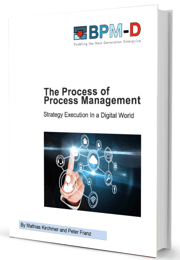
The Process of Process Management: Strategy Execution in a Digital World
Dr. Mathias Kirchmer & Peter Franz
Organizations need to execute their strategy systematically and deal proactively with our “digital world”. In effect, they must know how and when to modify or enhance their business processes, which processes are best candidates for intervention, and how to move rapidly from strategy to execution.
That’s where the Business Process Management-Discipline (BPM-Discipline) helps. The BPM-Discipline has become the “Strategy Execution Engine” of an organization...
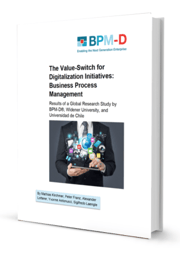
The Value Switch For Digitalization Initiatives: Business
Process Management
Dr. Mathias Kirchmer, Peter Franz, Alexander Lotterer,
Yvonne Antonuuci & Sigifredo Laengle
08/17/2016Results of a Global Research study of 250+ Organizations from BPM-D, Widener University & Universidad de Chile.
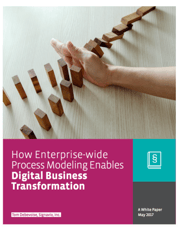 Enabling Digital Business Transformation with Enterprise-wide Process Modeling
Enabling Digital Business Transformation with Enterprise-wide Process Modeling
White Paper, Sponsored by Signavio
Today’s digital world creates a new change imperative. Businesses, government entities, and non-government organizations everywhere struggle with the pace, volume, and complexity of change. As a result, vast resources are wasted by multiple groups within the same organization all responding to the same change in isolation.
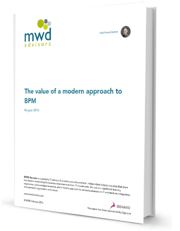 The Value of a Modern Approach to BPM
The Value of a Modern Approach to BPM
MWD Advisors, sponsored by Signavio
Today’s digital world creates a new change imperative. This ‘digital shift’ is creating a completely new business context for change than the one that most organisations are used to, or configured to deal with. The result of this new business context is that change programmes need to have broader scopes, and they need to deliver results in new ways...
The World of Business Transformation 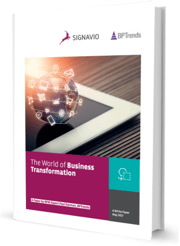
A Business Transformation Paper by BPM Expert Paul Harmon, BPTrends, Signavio
Transformation is the current name being given to business process improvement efforts. As the term has become popular, authors have described many different kinds of transformation efforts. This downloadable white paper focuses on Digital & Cognitive Business Transformation.
BPM Certification
Get the right BPM Training!
Sometimes books and blogs don't help and you just need to learn it from professionals. You can take lessons and learn about Business Process Management from experts and get certified at the end of the courses.
Being certified according to different institutions offering training...
"shows current and future employers or clients that you have the required knowledge and skills, making you a more attractive candidate for hiring and promotion." bpmn.org. Check out their website for training offers.
"means that an individual has:
- Achieved appropriate professional experience and/or education
- Passed a rigorous examination of 130 questions
- Agreed to abide by a professional code of conduct
- Committed to maintaining an active credential through meeting continuing professional development requirements" abbpmp.org. Check out their website for training offers.
If you want to learn more about BPM Certifications click here.
Top 10 OpEX Video Presentations
Hear from the best in your Industry!
Get all 10 exceptional Video Presentations from the Business Transformation & Operational Excellence World Summit. Hear from the experts of your industry how they discuss various topics concerning operational excellence.
Btoes.com
Business Transformation & Operational Excellence World Summit & Industry Awards (BTOES19). March 18-22, 2019, Loews Portofino Bay Hotel at Universal Orlando Resort®
It also hosts the Business Transformation & Operational Excellence Awards, which showcase globally the most outstanding organizational achievements through the application of Operational Excellence programs.
The summits hosts a number of private forums for C-Level & Global corporate-level leaders as well as business unit heads.
With over 150 speakers, over 100 sessions, 12 Keynotes, 9 Track Themes, 5 parallel tracks, 60+ track sessions, 50 roundtable discussions, 20 Interactive Workshops, 6 Thought Leader Panels, 5 Leaders Boardrooms, 5 co-located events, the Industry Awards Program, Site Visits, 20+ hours of social networking including 2 gala cocktail parties, dinners, numerous group activities, this is the ultimate event to benchmark, network and drive Operational Excellence to the next level.
Quick Links
There is a strong focus on Cultural Transformation, Customer Delight, Sustaining an Operational Excellence program, Need for end-to-end Business Transformation, Keeping up with new technologies/impact of digitalization and Leadership Buy-in & Understanding. We dedicated two tracks to advanced technologies, such as AI, Machine Learning, RPA, Predictive Analytics, Blockchain, Cloud infrastructure etc.
The agenda is designed to encourage active meaningful conversations though all day enhanced networking and interaction opportunities, including
-
All-day Refreshment & Themed Breaks
-
1¼ Hour Hot Breakfast Networking Sessions
-
1½ Hour Hot Plated Networking Lunches with Topic & Industry Sector focussed tables
-
1½ Hour Roundtable Sessions by Topic & Industry Sector.
-
Keynote & Themes Panel Sessions
-
Hosted Welcome Receptions from 5.30pm
-
Expanded more lavish Awards Program
-
Newly launched Night Summit for attendees to meet after dinner
For more information or to discuss the summit in more detail please schedule a call below,
Click here to schedule a call.
